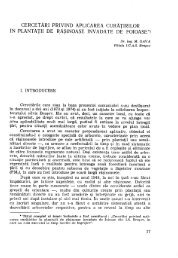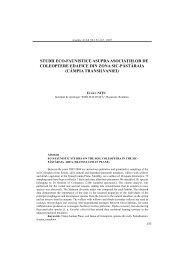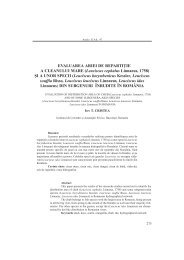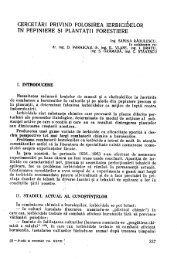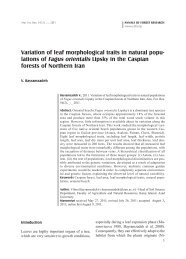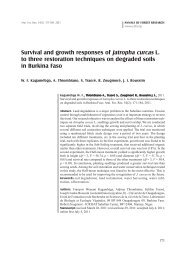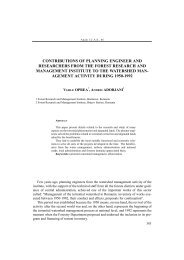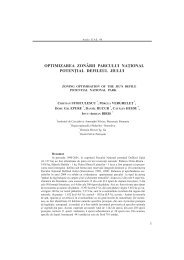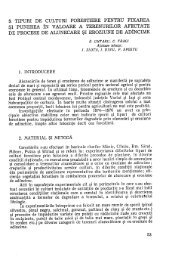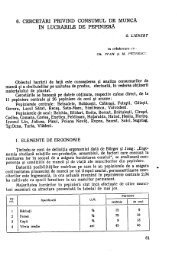Romania (Quercus cerris, Q. frainetto, Q. robur) and - EdituraSilvica.ro
Romania (Quercus cerris, Q. frainetto, Q. robur) and - EdituraSilvica.ro
Romania (Quercus cerris, Q. frainetto, Q. robur) and - EdituraSilvica.ro
You also want an ePaper? Increase the reach of your titles
YUMPU automatically turns print PDFs into web optimized ePapers that Google loves.
Ann. For. Res. 54(1): 57-71, 2011tool, to be used in further studies on <st<strong>ro</strong>ng>Quercus</st<strong>ro</strong>ng>spp. mycorrhizae, Cenoccocum geophilum beingthe exception of the already described morphotypeby Agerer (1987-2002).Although the number of described morphotypesis relatively high, at a specic timesnapshot there are fewer, a<strong>ro</strong>und 14 activemorphotypes. Most frequently encountered<st<strong>ro</strong>ng>and</st<strong>ro</strong>ng> dominating mycobiont, under normal<st<strong>ro</strong>ng>and</st<strong>ro</strong>ng> stressful conditions, was Cenococcumgeophilum, a good c<st<strong>ro</strong>ng>and</st<strong>ro</strong>ng>idate for in vit<strong>ro</strong> mycorrhization<st<strong>ro</strong>ng>and</st<strong>ro</strong>ng> further acclimatization of theplantlets. However, there is a geographical <st<strong>ro</strong>ng>and</st<strong>ro</strong>ng>host dependent pattern for the association ofdifferent morphotypes, as our study reveals. Ageneral recommendation stresses the necessity,for nurseries, to p<strong>ro</strong>vide seedlings with abundantmycorrhization, because the ectomycorrhizaecan imp<strong>ro</strong>ve the success of acclimatization(K<strong>ro</strong>pp & Langlois 1990).ReferencesAgerer R, ed (1987-2002) Colour Atlas of Ectomycorrhizae,1st-12th del., Einhorn-Verlag, SchwäbischGmünd.Azcón-Aguilar C., Barea J.M., 1997. Applying mycorrhizabiotechnology to horticulture: signicance <st<strong>ro</strong>ng>and</st<strong>ro</strong>ng>potentials. Sciencia Horticulturae 68(1-4): 1-24.Baxter J.W., Pickett S.T.A., Carrei<strong>ro</strong> M.M., Dighton J.,1999. Ectomycorrhizal diversity <st<strong>ro</strong>ng>and</st<strong>ro</strong>ng> community structurein oak forest st<st<strong>ro</strong>ng>and</st<strong>ro</strong>ng>s exposed to contrasting anth<strong>ro</strong>pogenicimpacts. Canadian Journal of Botany 77: 771-783.Bonfante P., 2003. Plants, Mycorrhizal Fungi <st<strong>ro</strong>ng>and</st<strong>ro</strong>ng> Endobacteria:a Dialog among Cells <st<strong>ro</strong>ng>and</st<strong>ro</strong>ng> Genomes. BiologicalBulletin 204: 215-220.Danielson R.M., Pruden M., 1989. The ectomycorrhizalstatus of urban spruce. Mycologia 81(3): 335-341.Gebhardt S., Neuhert K., Wöllecke J., Münzenberger, B.,Hüttl, R., 2007. Ectomycorrhizal community of red oak(<st<strong>ro</strong>ng>Quercus</st<strong>ro</strong>ng> rubra) of different age in the Lusatian lignitemining district, East Germany. Mycorrhiza 17(4): 278-290.Herrmann S., Munch J.C., Buscot F., 1998. A gnotobioticculture system with oak mic<strong>ro</strong>cuttings to study speciceffects of mycobionts on plant morphology before, <st<strong>ro</strong>ng>and</st<strong>ro</strong>ng>in early phase of ectomycorriza formation by Paxillusinvolutus <st<strong>ro</strong>ng>and</st<strong>ro</strong>ng> Piloderma c<strong>ro</strong>ceum. New Phytologist138(2): 2003-212.Jones M.D., Durell D.M., Harniman S.M., Claseen D.C.,70Research articlesSimard S.W., 1998. Ectomycorrhizal diversity of paperbirch <st<strong>ro</strong>ng>and</st<strong>ro</strong>ng> Douglas r seedlings in single species<st<strong>ro</strong>ng>and</st<strong>ro</strong>ng> mixed plots in the ICH zone of Southern BritishColumbia. Extension note 19. Ministry of Forests ResearchP<strong>ro</strong>gram. B.C.Kelly C.K., Bowler G., Pybus O., Harvey P.H., 2008. Phylogeny,niches <st<strong>ro</strong>ng>and</st<strong>ro</strong>ng> relative abundance in natural communities.Ecology 89(4): 962.970.Kernaghan G.R.S., Currah S., 1997. Russulaceous ectomycorrhizaeof Abies lasiocarpa <st<strong>ro</strong>ng>and</st<strong>ro</strong>ng> Picea engelmanii.Canadian Journal of Botany 75 (11): 1843-1850.Kranabetter J.M., Wylie T., 1998. Ectomycorrhizal communitystructure ac<strong>ro</strong>ss forest openings on naturally regeneratedwestern hemlock seedlings. Canadian Journalof Botany 76: 189-196.K<strong>ro</strong>pp B.R., Langlois C.G., 1990. Ectomycorrhizae inreforestation. Canadian Journal of Forest Research 20:438-458.Langley J.A., Hungate B.A, 2003. Mycorrhizal cont<strong>ro</strong>l onbelowg<strong>ro</strong>und litter quality. Ecology 84(9): 2303-2312.Legendre P., Legendre L. 1998. Numerical Ecology. (secondedition). Elsevier Science.Martinez-Amores E., Valdes M., Quintos M., 1991. Seedlingg<strong>ro</strong>wth <st<strong>ro</strong>ng>and</st<strong>ro</strong>ng> ectomycorrhizal colonization of Pinuspatula <st<strong>ro</strong>ng>and</st<strong>ro</strong>ng> P. radiata inoculated with spores of Helvellalacunosa, Russula brevipes or Lycoperdon perlatum.New Forest 4: 237-245.Michener W.K., Baerwald T.J., Firth P., Palmer M.A.,Rosenberger, J.L., D<st<strong>ro</strong>ng>and</st<strong>ro</strong>ng>lin, E.A., Zimmerman, H.2001. Dening <st<strong>ro</strong>ng>and</st<strong>ro</strong>ng> unraveling biocomplexity. BioScience51(12): 1018-1023.Moser M., Petersen C.A., D’allura J.A., Southworth D.,2005. Comparison of ectomycorrhizas of (Fagaceae) onserpentine <st<strong>ro</strong>ng>and</st<strong>ro</strong>ng> non-serpentine soils in southwestern Oregon.American Journal of Botany 92: 224-230.NSF. 1999. Biocomplexity: Phase I – Research on thefunctional interrelationship between mic<strong>ro</strong>organisms<st<strong>ro</strong>ng>and</st<strong>ro</strong>ng> biological, chemical, geological, physical <st<strong>ro</strong>ng>and</st<strong>ro</strong>ng> socialsystems. Arlington (VA): National Science Foundation.Nylund J.-E., Kasimir A., Str<st<strong>ro</strong>ng>and</st<strong>ro</strong>ng>berg Arveby A., UnestramT., 1992. Simple diagnosis of ectomycorrhiza formation<st<strong>ro</strong>ng>and</st<strong>ro</strong>ng> demonstration of the architecture of the Hartig netby means of clearing technique. Eu<strong>ro</strong>pean Journal ofForest Pathology 12: 103-107.Rai M.K., 2001. Current advances in mycorrhization <st<strong>ro</strong>ng>and</st<strong>ro</strong>ng>mic<strong>ro</strong>p<strong>ro</strong>pagation. In vit<strong>ro</strong> cellular <st<strong>ro</strong>ng>and</st<strong>ro</strong>ng> developmentalbiology 37(20): 101-132.Selosse M.A., Richard F., He X., Simard S.V., 2006. Mycorrhizalnetworks: des liasons dangereuses? Trends inEcology <st<strong>ro</strong>ng>and</st<strong>ro</strong>ng> Evolution 21(11): 621-627.Singh G., 2004. Plant systematics: An integrated app<strong>ro</strong>ach.Science Publishers inc., New Hampshire, USA.Timofte A., 2007. Cercetri privind variabilitateasomaclonal în embriogeneza somatic la stejar. [Researchabout the clonal variability in the somatic embriogenesisof <st<strong>ro</strong>ng>Quercus</st<strong>ro</strong>ng>]. Ph D. Thesis. University ofag<strong>ro</strong>nomy <st<strong>ro</strong>ng>and</st<strong>ro</strong>ng> veterinary sciences. Horticulture faculty.



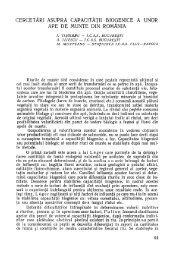
![studiu privind conditiilb] de vegetatie ale ... - EdituraSilvica.ro](https://img.yumpu.com/50877313/1/175x260/studiu-privind-conditiilb-de-vegetatie-ale-editurasilvicaro.jpg?quality=85)

